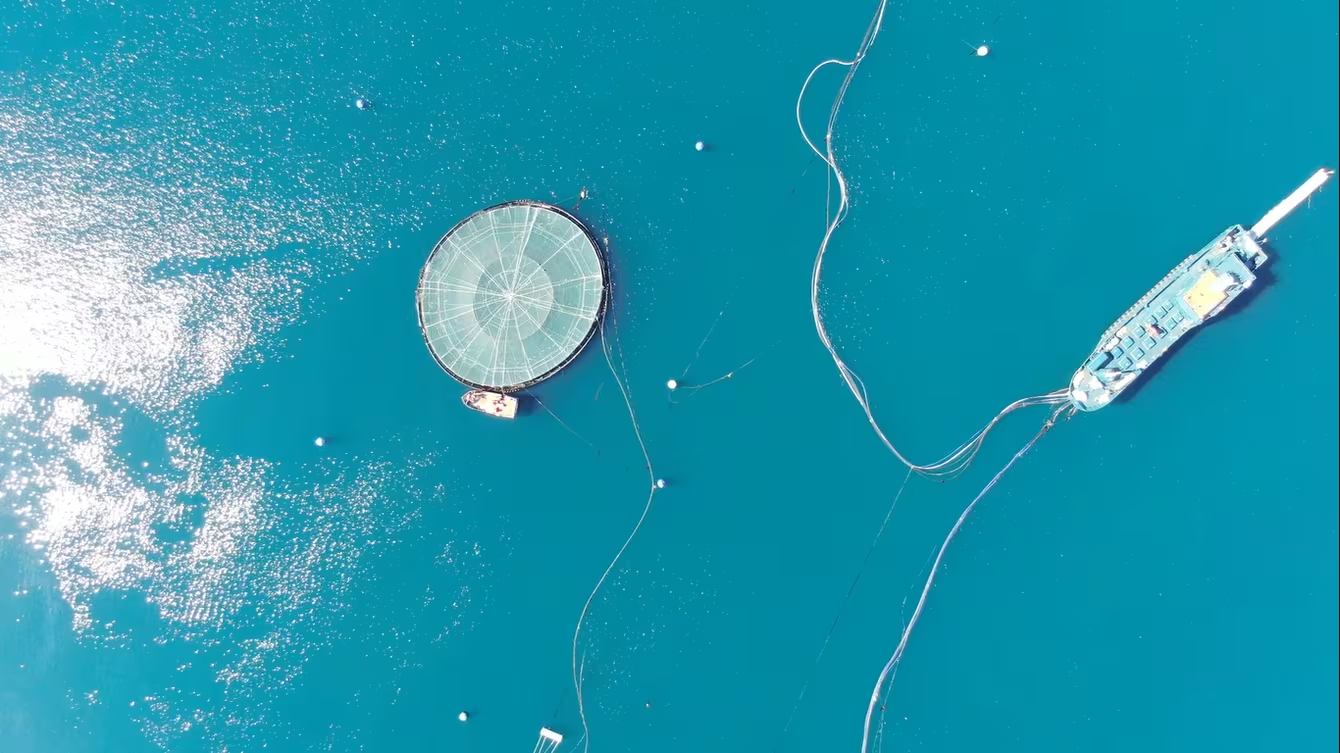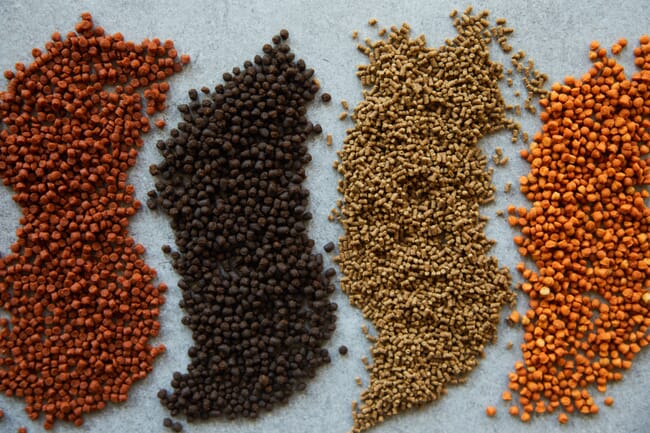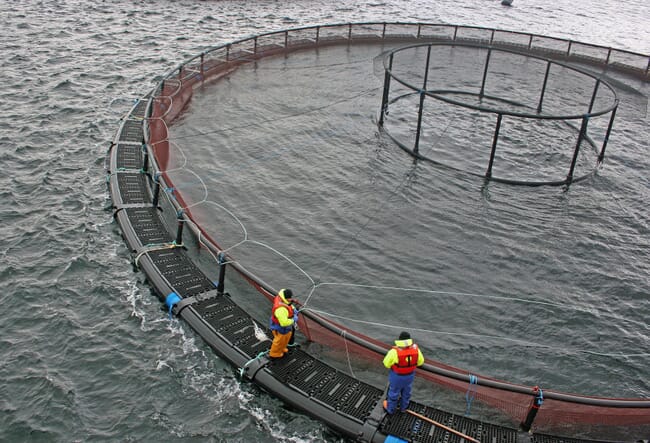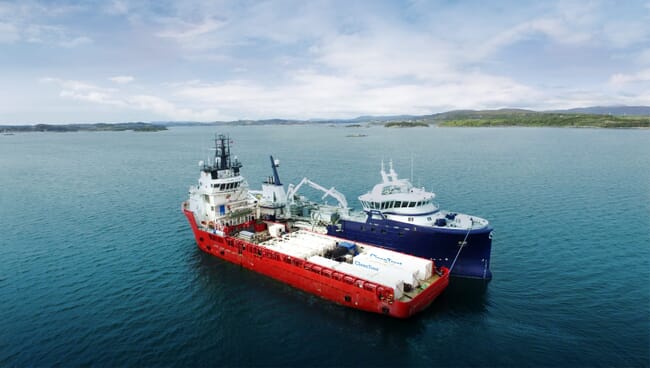
The aquaculture industry must learn to balance the trade-offs between environmentally sustainable production and fish welfare © EcoSea
In parallel, recognition of the importance of securing good welfare for farmed fish is growing. The term “fish welfare” was rarely used in aquaculture or fisheries research before the turn of the century, yet over 5,000 scientific publications have mentioned it in the last decade.
More research into fish behaviour, including their capacity to learn, has lent extraordinary insights into the lives of fish. As understanding of fish cognition grows, so to do societal expectations of acceptable fish welfare.
Consumers will pay more for products with eco-labelling or animal welfare certifications, as shown by grocery store prices for free range chicken eggs and dolphin friendly tuna. It is in the best interest of farmers to improve fish welfare, not only because it can improve growth rates, but also because consumer opinion is powerful in dictating markets.
Farming fish in a way that is both environmentally and welfare friendly makes perfect sense. But there are many instances across aquaculture where either environmental sustainability or fish welfare is sacrificed in favour of the other.
In a new paper published in Aquaculture Environment Interactions, we highlight five case studies where environmental and welfare protection principles do not align. Our purpose was not to advocate for animal welfare over environmental impacts or vice versa. Instead, we wanted to show that conflicts between the two goals of environmentally sustainable aquaculture and fish welfare exist, and these conflicts should be identified as early as possible to prevent either goal from falling through the cracks.
Case 1: Selecting for production efficiency can trade off against welfare
The recent decision by the Norwegian government to halt production of triploid salmon is a clear environment-welfare trade-off. Triploid salmon have an extra set of chromosomes, created by shocking the eggs with heat or pressure. These fish are infertile, which means that individuals that escape from sea cages cannot interbreed with wild salmon and compromise the wild gene pool. This is a good thing from an environmental perspective. However, triploids have higher incidences of emaciation, poorer product quality and lower survival than diploid fish, leading to the decision to halt their production. This decision prioritised the welfare of farmed fish over the ecological consequences of escaped fertile farmed fish, highlighting a clear trade-off.
Case 2: Feeds with reduced wild fish content may benefit wild fish populations but can create challenges for farmed fish welfare
Innovations in feed composition and feed delivery have reduced the amount of fish meal and fish oil needed to produce farmed fish, effectively sparing these valuable resources provided by fisheries. This has been achieved through increased use of a range of alternative ingredients, including plant-based products supplemented by animal offal.

Substituting marine-derived nutrients with terrestrial nutrients leads to challenges in feed quality © CAT
However, the right nutrition is crucial for maintaining fish health and substituting marine-derived nutrients with terrestrial nutrients leads to challenges in feed quality. For example, aquaculture feeds that are low in fish oil and high in vegetable oil can negatively affect growth rate, immunity and stress responses in a range of farmed species, leading to poorer welfare outcomes. Ongoing research must target development of feeds that use minimal amounts of wild-caught fish without compromising the health of farmed ones.
Case 3: Environmental regulation sometimes prohibits farms from being sited where fish welfare will be maximised
To establish a new fish farm, producers must navigate environmental protection legislation and local regulations, while minimising overlap with other users of marine space. This can prevent farms from being sited in locations that best support fish health.
For instance, in many countries there is a push for marine fish aquaculture to be relocated to more offshore and/or exposed locations. Offshore waters have fewer users and often have stronger or more consistent currents, meaning fish waste doesn’t build up beneath farms. Oxygen levels are also maintained by the constant flow of water through the cages.
However, these benefits can be outweighed if currents require fish to swim too quickly, increasing their energy needs and stopping them from performing other behaviours. In extreme cases, strong currents can cause fish to become exhausted and eventually be pressed against the net wall, resulting in injury, distress and eventually death. Fish-focused engineering will be essential to support fish welfare in future offshore and exposed farms.

Offshore waters have stronger currents, which is ideal for waste dispersal but can present welfare challenges for fish © Gael Force
Case 4: Land-based farming reduces disease transmission and waste export but presents new welfare challenges
There is growing land-based aquaculture production of species more typically grown out in sea cages, such as Atlantic salmon. Land-based aquaculture can avoid some of the environmental impacts and disease risks associated with coastal sea-cage fish farming, especially if biosecurity measures are observed. But rearing fish in new farming systems can create new welfare challenges, such as changes related to species behaviour (eg aggression or collisions) and the risk of system failures. In land-based systems, pump breakdowns or water quality issues can lead to mass mortalities in hours or even minutes. A recent example is the loss of 500,000 Atlantic salmon in a Florida facility due to a filter malfunction.
Case 5: Disease control can trade off the welfare of farmed and wild fish
Salmon lice are the most important pest for salmon farmers in the Northern Hemisphere, and because most salmon farming occurs in sea cages that are open to the wider environment, lice produced on farmed hosts can spread to wild salmon and trout. To limit impacts on both farmed and wild salmonids, regulators in most jurisdictions require salmon farmers to manage lice densities by prevention, treatment or early harvest. For decades, this was primarily achieved using chemical treatments, with relatively limited impact on farmed fish welfare, but a negative environmental impact as chemicals were released into the surrounding ecosystem. Chemical treatments have been reduced recently, as sea lice have developed resistance to many substances, forcing farmers to use alternative methods that put fish welfare at risk.

Salmon farmers have previously relied on chemical treatments to address sea lice challenges, but this has taken a toll on the environment © Benchmark
These new methods have environmental benefits as they do not release chemicals into the environment, but they introduce new challenges for fish welfare. Mechanical treatments work by brushing or spraying the salmon with water jets to dislodge lice, while thermal treatments require salmon to be exposed to comparatively warm water (up to 34 °C) for short periods until the lice fall off. These methods cause wounds and higher levels of mortality than the previous chemical treatments.
Several species of cleaner fish are also stocked for “salmon-friendly” biological control, eating lice off the farmed salmon. However, despite the enormous number of cleaner fish used in sea-cages annually (~50-60 million), they typically delay rather than prevent the need for mechanical or thermal treatments. Meanwhile, the cleaner fish themselves are vulnerable to disease and other causes of poor welfare and mortality in sea cages. The welfare burden that was previously borne by farmed salmon alone has been partly shifted to cleaner fishes, animals that in theory – and law – have the same rights as salmon.
So why do these types of trade-offs arise in aquaculture?
It is likely that many trade-offs between welfare and the environment are not made consciously.
Advances in environmentally sustainable practices in aquaculture are often implemented without considering the impacts on fish welfare and vice versa – whether it be new farming environments or new methods of disease control. Researchers and research groups often focus on either animal welfare or environmental issues, and seldom both at the same time. Similarly, animal welfare and environmental protection are often overseen by different government bodies, in line with separate pieces of legislation. Decisions are therefore often made from a single perspective, and this likely exacerbates these trade-offs.
We encourage discussion about potential strategies to improve the balance between fish welfare and environmental protection. Effective regulation is needed to safeguard both. To promote discussions around intertwined welfare−environment trade-offs, more collaboration between welfare and environment policymakers is needed.
Advances in technology and changes in management practices in new, more environmentally friendly farming systems can also help overcome welfare challenges. More conversation will generate the best possible outcomes for the two closely aligned goals of ethical and ecologically sustainable aquaculture.




